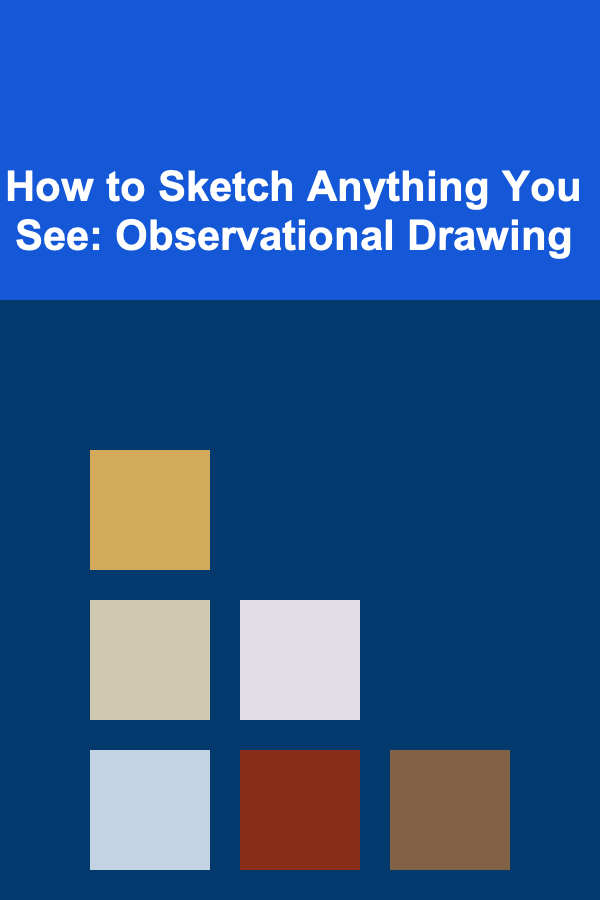
How to Sketch Anything You See: Observational Drawing
ebook include PDF & Audio bundle (Micro Guide)
$12.99$9.99
Limited Time Offer! Order within the next:

Drawing is one of the most rewarding and fulfilling activities that can deepen your understanding of the world around you. Whether you're an artist looking to improve your skills or someone who simply wants to express themselves visually, the ability to sketch accurately what you see is an essential skill. This type of drawing is known as observational drawing, and it involves drawing from real-life objects, scenes, or people rather than relying on imagination or photographs.
In this guide, we will explore the key principles and techniques that will help you master observational drawing. We will cover everything from understanding perspective and proportions to practicing the fundamentals of line, shadow, and texture. No matter your experience level, with the right tools, mindset, and dedication, you can improve your ability to sketch anything you see.
The Importance of Observational Drawing
Observational drawing is the foundation of most art forms. Whether you're an illustrator, a fine artist, or an architect, the ability to translate what you observe onto paper is vital. Unlike drawing from imagination, observational drawing challenges your eyes and your hand to work in sync. It trains your brain to focus on details, to interpret depth and dimension, and to translate those perceptions into visual language.
Key Benefits of Observational Drawing:
- Improved Observation Skills: Regular practice helps you sharpen your ability to notice details that you might otherwise overlook.
- Better Understanding of Proportions and Anatomy: Sketching the human body, animals, or objects gives you a deeper understanding of how things are structured and how they fit together.
- Enhanced Creativity: By training your eyes and your hands, you develop the ability to think creatively and translate the world into a variety of visual forms.
- Foundation for Other Art Forms: Observational drawing serves as the bedrock for more complex art forms like portraiture, still life, and even digital art.
By honing your observational drawing skills, you not only become a better artist, but you also develop a unique way of seeing the world. Every object or person you encounter becomes a subject waiting to be explored and translated onto paper.
Setting Up Your Workspace
Before diving into your sketching, it's essential to set up a comfortable and conducive workspace. A good environment helps you focus on your subject and the process of drawing, making it easier to connect with what you're observing.
Choosing the Right Tools
While you can sketch with almost anything, certain tools will enhance your ability to create detailed, accurate sketches. Here's a basic list of supplies to consider:
- Sketchbook: Choose a sketchbook that is comfortable to use, preferably with smooth paper that can handle various mediums like pencils, charcoal, or ink.
- Pencils: Start with a basic set of pencils (ranging from H to 6B) for different shading effects. The harder pencils (H) are good for light lines, while the softer ones (B) are better for darker, deeper lines.
- Erasers: A kneaded eraser allows you to subtly remove graphite or create highlights, while a regular eraser can be used for more substantial corrections.
- Sharpener: Keeping your pencils sharp is crucial for precision.
- Ruler and Compass: These tools are helpful when drawing geometric shapes or for perfecting angles and curves.
Lighting and Positioning
Make sure you have proper lighting that allows you to see your subject clearly. Natural light works best, but if you're sketching indoors, position yourself near a window or use artificial lighting that mimics daylight.
Comfortable Seating and Posture
Good posture helps you focus on your drawing and prevents fatigue. Sit in a comfortable chair with your sketchbook at eye level to avoid straining your neck or back.
The Fundamentals of Observational Drawing
Before tackling complex subjects, it's crucial to master the basic skills that will enable you to accurately capture anything you see. These include:
3.1 Understanding Proportions
Proportions refer to the relative sizes of different parts of an object or subject. When you're drawing, getting the proportions right is essential for creating a realistic and accurate representation.
Key Tips for Proportions:
- Use Guidelines: Start by lightly sketching basic shapes and lines that represent the object or scene. This will help you position elements in proportion to one another.
- Measure with Your Pencil: Hold your pencil at arm's length and use it to measure the length of one part of the subject relative to another. For example, if you're drawing a person, you can measure how many "head lengths" fit into the torso, arms, or legs.
- Check for Symmetry: Many objects and subjects have symmetrical features. Use symmetry as a guide to ensure you're placing elements in the correct position.
3.2 Observing Perspective
Perspective is how we perceive depth and dimension in the real world. It helps you represent the three-dimensional world on a two-dimensional surface. There are two main types of perspective to be aware of: linear perspective and atmospheric perspective.
- Linear Perspective: This refers to the way parallel lines appear to converge as they move into the distance. One-point perspective is when all lines converge to a single point on the horizon. Two-point and three-point perspectives involve multiple points of convergence and allow you to draw more complex structures.
- Atmospheric Perspective: This describes how objects that are farther away appear lighter, less detailed, and more blurred. It mimics the effect of the atmosphere on distant objects.
By understanding perspective, you can create the illusion of depth and realism in your sketches.
3.3 Shading and Light
Shading is an essential aspect of creating dimension in your drawing. The way light interacts with an object determines where shadows fall and how highlights appear.
Key Tips for Shading:
- Identify the Light Source: Determine where the light is coming from in your scene. This will help you understand where shadows will fall.
- Use Gradation: Use softer pencils (B range) for darker areas and harder pencils (H range) for lighter areas. Gradate from light to dark to create smooth transitions between tones.
- Avoid Overworking: Don't overdo the shading. Subtlety is key in achieving realistic effects.
3.4 Contour Drawing
Contour drawing is the process of drawing the edges and outlines of an object without looking at your paper. This technique encourages your hand to follow your eyes, helping you focus on the details of the subject. While challenging at first, it sharpens your ability to observe and understand the structure of objects.
How to Practice Contour Drawing:
- Choose a simple object to draw.
- Look at the object and slowly trace its contours with your eyes.
- Begin drawing the object on paper, keeping your eyes on the object and not on your drawing.
- Focus on capturing the shapes and lines accurately without worrying about perfection.
3.5 Gesture Drawing
Gesture drawing is a technique used primarily for sketching the human figure or animals. It involves quickly capturing the overall pose and movement of a subject rather than focusing on intricate details. The goal is to sketch the subject's action and energy.
Gesture drawing encourages spontaneity and fluidity in your sketches and is a great way to warm up before diving into more detailed work.
Advanced Techniques for Mastering Observational Drawing
Once you've mastered the basics of observational drawing, it's time to take your skills to the next level. Here are a few advanced techniques to help you refine your approach and tackle more complex subjects:
4.1 Drawing from Life
While photographs can be helpful references, drawing from life is the most valuable practice for improving observational skills. Whether it's a still life, a landscape, or a live model, drawing from real life sharpens your ability to capture the nuances of light, texture, and form.
4.2 Using Grids for Accuracy
Grids can be used as a tool to break down complex subjects into smaller, more manageable sections. You can draw a grid over your reference image and a corresponding grid on your drawing surface. By copying each section of the image into your drawing grid, you can achieve more accurate proportions and placement.
4.3 Adding Texture and Detail
Texture is crucial for adding realism to your drawing. By observing the texture of surfaces, such as the roughness of a tree bark or the smoothness of a glass, you can convey more depth and interest in your sketches.
How to Add Texture:
- Use short, quick strokes for rough textures.
- Use smooth, long strokes for soft, shiny textures.
- Focus on the way light interacts with textures and use shading to convey this.
4.4 Experimenting with Different Mediums
While graphite is the most common medium for observational drawing, don't hesitate to experiment with other materials. Charcoal, ink, colored pencils, and even watercolors can add richness and variety to your sketches. Experimenting with different mediums will expand your drawing capabilities and help you develop a unique style.
Building Consistency Through Practice
Like any skill, observational drawing requires consistent practice. The more you practice, the better you will become at seeing and interpreting the world around you. Make it a habit to draw every day, whether it's a quick 15-minute sketch or a more detailed study.
Tips for Practicing Regularly:
- Start Small: Don't try to tackle complex subjects right away. Start with simple objects and work your way up.
- Challenge Yourself: Push yourself by drawing subjects that you find challenging, whether it's hands, animals, or intricate objects.
- Use Sketchbooks: Keep a sketchbook dedicated to your practice. Document your progress and review your work to see areas for improvement.
Conclusion
Observational drawing is an invaluable skill for artists of all levels. By improving your ability to draw what you see, you not only enhance your technical drawing skills but also develop a deeper connection with the world around you. Whether you're sketching a simple object or capturing the complexities of human anatomy, the ability to observe and replicate what's in front of you is the key to mastering the art of drawing.
With dedication, patience, and regular practice, you can learn how to sketch anything you see and turn your observations into works of art. Keep refining your techniques, exploring new subjects, and pushing the boundaries of your creativity. Observational drawing is a lifelong journey, and each sketch brings you one step closer to mastery.
Reading More From Our Other Websites
- [Ziplining Tip 101] How to Choose the Ideal Zipline Backpack for Minimalist Travelers
- [Home Soundproofing 101] How to Soundproof Your Ceiling to Prevent Noise From Above
- [Organization Tip 101] How to Set Up a Family Night Station for Quality Time
- [Personal Care Tips 101] How to Use Antiperspirant for All-Day Protection
- [Organization Tip 101] How to Create a Kid-Friendly Living Room Without Sacrificing Style
- [Weaving Tip 101] Creative Fusion: How to Crochet Into Your Loom-Weaving Creations
- [Home Budget 101] How to Budget for Health Care Costs While Managing Your Home Finances
- [Small Business 101] Small Business Marketing: Effective Digital Strategies for Beginners
- [Home Renovating 101] How to Maintain Your Renovated Home to Keep It Looking Fresh
- [Horseback Riding Tip 101] The Essentials of Horse Tack: Choosing and Fitting the Perfect Saddle

Fleet Manager's Toolkit: Essential Tools, Tips, and Techniques for Efficient Transportation Management
Read More
How to Store Your Holiday Gifts Before Giving Them Away
Read More
Why An Organized Workspace Improves Your Professional Image
Read More
How To Minimize the Appearance of Fine Lines
Read More
10 Tips for Choosing the Right Personal Loan for Your Needs
Read More
10 Tips for Using a Daily Planner to Achieve Your Fitness Goals
Read MoreOther Products

Fleet Manager's Toolkit: Essential Tools, Tips, and Techniques for Efficient Transportation Management
Read More
How to Store Your Holiday Gifts Before Giving Them Away
Read More
Why An Organized Workspace Improves Your Professional Image
Read More
How To Minimize the Appearance of Fine Lines
Read More
10 Tips for Choosing the Right Personal Loan for Your Needs
Read More